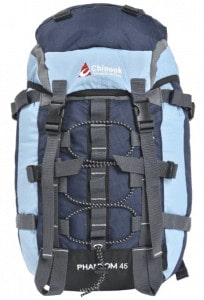As many hikers will tell you you will probably end up going through several backpacks if you hike or backpack for any length of time. I know I have went through several and some of which have been bad decisions. I am writing this article to help you know what to expect and look for when choosing a backpack.
Framed Backpacks

Framed backpacks are designed to transfer weight from the shoulders to the hips. This helps you to carry heavier weight better because the hips can handle more weight and are also closer to your center of gravity. This makes framed backpacks more comfortable with heavy loads.
You will find that framed backpacks are usually larger in size and more expensive than frameless backpacks.
External Frame – External frame backpacks have a separate aluminum frame that the bag attaches to. They have been mostly replaced by internal frames.
Internal Frame – Internal frame backpacks are much more popular and have basically replace the external frames. There are three common support structures:
- Stay – A stay is a flat aluminum rod about 1 inch wide that runs parallel to the spine.
- Framesheet – A framesheet is a pane of plastic that covers your back.
- Peripheral Rod – A peripheral rod borders the edge of the backpack’s perimeter.
Frameless Backpacks

A frameless backpack does not have a structure. They are more comfortable with lighter loads but after exceeding the maximum load capacity they are not very comfortable. The average load capacity for these types of backpacks are usually no more than 30 pounds. Frameless backpacks are generally smaller in size and cheaper than framed backpacks.
Expert Tip: Before choosing a backpack you should decide on what you are planning to carry in it.
Things to Look for in a Backpack
Pockets – More pockets on your backpack will add more convenience to the pack and you will be able to have more organization. For example, I keep my bug repellent in a side pouch so that I can access it quickly if I need it rather than digging in the pack. The more pockets your pack has the heavier it will be.
Back Panels – Back panels are panels of mesh padding that are there to allow airflow on your back. This helps to keep you from overheating.

Hydration Sleeve – A hydration sleeve is a sleeve or pocket inside your bag that is there to let you slide your hydration bladder in. Many people remove these because they do not use a hydration bladder. This will allow them to save a little bit of weight.
Zippers – It is usually better to avoid zippers on your backpack because they can fail and get snagged. If you do have a zipper try to find a large toothed zipper.
Compression Straps – Compression straps let you compress your pack down to make it smaller. This helps you to manage your center of gravity. You can also use them to attach things like trekking polls or clothes that are drying to your pack.
Top Lids – Top lids are pockets on top of your backpack that fold over the main compartment. You can use these to store items you need to get to often.
Daisy Chains – A daisy chain is a strip of nylon webbing that has built in loops in it. You can use these to attach things to the outside of your pack.
Pack Covers – Some backpacks have built-in pack covers that are waterproof. You simply pull them out and cover the pack with them to keep them from getting wet.
Comfort Features
Compression Systems – On some backpacks you’ll find compression systems made of nylon webbing or bungee cords. You can use these to compress down overall size of the backpack so that it is less bulk and has a better center of gravity
Adjustable Backlength – With an adjustable backlength you can adjust the backlength of the backpack to the length of your spine. This feature will only be found on a frame backpack rather than frameless backpacks.
Waist Belts – When correctly fitted, they can help to transfer the weight of your pack to your hips. You can often adjust these to fit your waist size.
I hope this article has helped you to decide what you’re looking for in your next backpack. If you’re like me you will find yourself often looking at new backpacks to help to save with weight and to maybe and more comfort on your trips. If you found this article helpful please be sure to share it with your fellow hikers. If you have any questions or comments please leave a comment below or contact me via my contact page.
